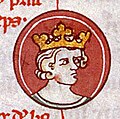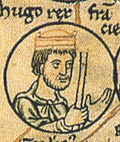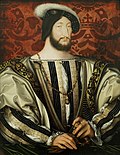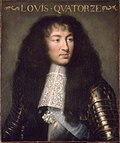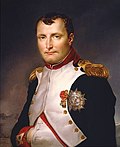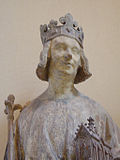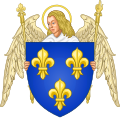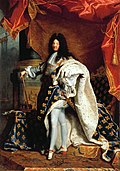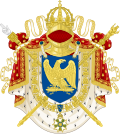| Portrait | Name | Arms | Reign | Succession | Life details |
|---|
 | Hugh "Capet"
Hugues [l] | | 1 June 987 [xiii] – 24 October 996
(9 years, 4 months and 23 days) | Elected king by the French nobles. Son of Hugh the Great and grandson of Robert I [m] | c. 941 – 24 October 996
(aged c. 55)
Duke of the Franks since 956. Died of natural causes. |
 | Robert II "the Pious" | 24 October 996 [xiv] – 20 July 1031
(34 years, 8 months and 26 days) | Only son of Hugh "Capet" | c. 970 – 20 July 1031
(aged approx. 60)
Married thrice, getting excommunicated by the Catholic Church. Incorporated the Duchy of Burgundy |
| Hughes
(junior king) [n] | 19 June 1017 – 17 September 1025
(under Robert II) | Son of Robert II | c. 1007 – 17 September 1025
(aged approx. 18) |
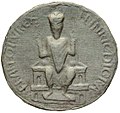 | Henry I
Henri | 20 July 1031 [xv] – 4 August 1060
(29 years and 15 days) | Son of Robert II | 4 May 1008 – 4 August 1060
(aged 52)
His reign was marked with internal struggle against feudal lords |
 | Philip I "the Amorous"
Philippe | 4 August 1060 [xvi] – 29 July 1108
(47 years, 11 months and 25 days) | Son of Henry I | 1052 – 29 July 1108
(aged 56)
Ruled under the regency of Anne of Kiev and Count Baldwin V until 1066 |
 | Louis VI "the Fat" | 29 July 1108 [xvii] – 1 August 1137
(29 years and 3 days) | Son of Philip I | 1081 – 1 August 1137
(aged 55)
His reign contributed to the centralization of royal power. First king to wage war against the English |
 | Philippe
(junior king) [n] | 14 April 1129 – 13 October 1131
(under Louis VI) | Son of Louis VI | 29 August 1116 – 13 October 1131
(aged 15) |
 | Louis VII "the Young" | 1 August 1137 [xviii] – 18 September 1180
(43 years, 1 month and 17 days) | Son of Louis VI | 1120 – 18 September 1180
(aged 60)
Known for his rivalry with Henry II of England and his military campaigns during the Second Crusade |
 | Philip II "Augustus"
Philippe Auguste |  | 18 September 1180 [xix] – 14 July 1223
(42 years, 9 months and 26 days) | Son of Louis VII | 21 August 1165 – 14 July 1223
(aged 57)
Regarded as one of the greatest French rulers. First monarch to style himself as "King of France" |
 | Louis VIII "the Lion" | 14 July 1223 [xx] – 8 November 1226
(3 years, 3 months and 25 days) | Son of Philp II | 5 September 1187 – 8 November 1226
(aged 39)
Proclaimed king of England in 1216, after which he led an unsuccessful invasion |
 | Louis IX "the Saint" | 8 November 1226 [xxi] – 25 August 1270
(43 years, 9 months and 17 days) | Son of Louis VIII | 25 April 1214 – 25 August 1270
(aged 56)
Ruled under the regency of Blanche of Castile until 1234. Died during the 8th Crusade; only king to be venerated by the Catholic Church |
 | Philip III "the Bold"
Philippe | 25 August 1270 [xxii] – 5 October 1285
(15 years, 1 month and 10 days) | Son of Louis IX | 3 April 1245 – 5 October 1285
(aged 40)
Greatly expanded French influence in Europe. Died of a fever |
 | Philip IV "the Fair"
Philippe |  | 5 October 1285 [xxiii] – 29 November 1314
(29 years, 1 month and 24 days) | Son of Philip III | 1268 – 29 November 1314
(aged 46)
King of Navarre (as Philip I) since 16 August 1284, following his marriage with Joan I. Remembered for his struggle with the Roman papacy and his consolidation of royal power, which helped to reduce the influence of feudal lords |
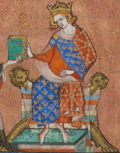 | Louis X "the Quarreller" | 29 November 1314 [xxiv] – 5 June 1316
(1 year, 6 months and 7 days) | Son of Philip IV | 3 October 1289 – 5 June 1316
(aged 26)
King of Navarre (as Louis I) since 2 April 1305. His short reign was marked by conflicts with the nobility |
 | John I "the Posthumous"
Jean | 15–19 November 1316
(4 days) | Posthumous son of Louis X | King for the four days he lived; youngest and shortest undisputed monarch in French history [o] |
 | Philip V "the Tall"
Philippe | 20 November 1316 [xxv] – 3 January 1322
(5 years, 1 month and 14 days) | Son of Philip IV and uncle of John I | 1293/4 – 3 January 1322
(aged 28–29)
King of Navarre as Philip II.
Died without a male heir |
 | Charles IV "the Fair" | 3 January 1322 [xxvi] – 1 February 1328
(6 years and 29 days) | Son of Philip IV and younger brother of Philip V | 1294 – 1 February 1328
(aged 34)
King of Navarre as Charles I. Died without a male heir, ending the direct line of Capetians |

